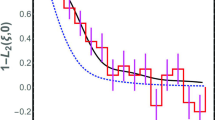Abstract
We propose and study a model with glassy behavior. The state space of the model is given by all triangulations of a sphere with n nodes, half of which are red and half are blue. Red nodes want to have 5 neighbors while blue ones want 7. Energies of nodes with other numbers of neighbors are supposed to be positive. The dynamics is that of flipping the diagonal of two adjacent triangles, with a temperature dependent probability. We show that this system has an approach to a steady state which is exponentially slow, and show that the stationary state is unordered. We also study the local energy landscape and show that it has the hierarchical structure known from spin glasses. Finally, we show that the evolution can be described as that of a rarefied gas with spontaneous generation of particles and annihilating collisions.
Similar content being viewed by others
References
Aharonov, E., Bouchbinder, E., Hentschel, H.G.E., Ilyin, V., Makedonska, N., Procaccia, I., Schupper, N.: Direct identification of the glass transition: growing length scale and the onset of plasticity. Europhys. Lett. 77, 56002 (2007)
Aste, T., Sherrington, D.: Glass transition in self-organizing cellular patterns. J. Phys. A 32, 7049–7056 (1999)
Ben Arous, G., Černý, J.: Dynamics of trap models. In: Bovier, A., Dunlop, F., van Enter, A., Dalibard, J., (eds.) Mathematical Statistical Physics. Les Houches, session LXXXIII. Elsevier, Amsterdam (2006)
Buhot, A., Garrahan, J.P., Scherrington, D.: Simple strong glass forming models: mean-filed solution with activation. J. Phys. A 36, 307–328 (2003)
Collet, P., Eckmann, J.-P.: Dynamics of triangulations. J. Stat. Phys. 121, 1073–1081 (2005)
Davison, L., Sherrington, D.: Glassy behaviour in a simple topological model. J. Phys. A 33, 8615–8625 (2000)
de Bakker, B., Smit, J.: Gravitational binding in 4d dynamical triangulation. Nucl. Phys. B 484, 476–492 (1997)
Deng, D., Aragon, A., Yip, S.: Topological features of structural relaxations in a 2-dimensional model atomic glass, I and II. Philos. Trans. R. Soc. Lond. Ser. A—Math. Phys. Eng. Sci. 329, 549 (1989)
Deng, D., Aragon, A., Yip, S.: Topological features of structural relaxations in a 2-dimensional model atomic glass, I and II. Philos. Trans. R. Soc. Lond. Ser. A—Math. Phys. Eng. Sci. 329, 613 (1989)
Hentschel, H., Ilyin, V., Makedonska, N., Procaccia, I., Schupper, N.: Statistical mechanics of the glass transition as revealed by a Voronoi tesselation. Phys. Rev. E 75, 050404(R) (2007)
Kownacki, J.-P.: Freezing of triangulations. Eur. Phys. J. B 38, 485–494 (2004)
Malyshev, V.A.: Probability related to quantum gravitation: planar gravitation. Uspekhi Mat. Nauk 54, 3–46 (1999)
Mori, R., Nakamoto, A., Ota, K.: Diagonal flips in Hamiltonian triangulations on the sphere. Graphs Combin. 19, 413–418 (2003)
Negami, S.: Diagonal flips of triangulations on surfaces, a survey. In: Proceedings of the 10th Workshop on Topological Graph Theory (Yokohama, 1998), vol. 47 (1999)
Perera, D.N., Harrowell, P.: Stability and structure of a supercooled liquid mixture in two dimensions. Phys. Rev. E 59, 5721–5743 (1999)
Schliecker, G.: Structure and dynamics of cellular systems. Adv. Phys. 51, 1319–1378 (2002)
Sherrington, D., Davison, L., Buhot, A., Garraham, J.P.: Glassy behaviour in simple kinetically constrained models: Topological networks, lattice analogues and annihilation diffusion. J. Phys.: Condens. Matter 14, 1673–1682 (2002)
Tutte, W.T.: A census of planar triangulations. Can. J. Math. 14, 21–38 (1962)
van den Berg, J., Kesten, H.: Asymptotic density in a coalescing random walk model. Ann. Probab. 28, 303–352 (2000)
Wagner, K.: Bemerkungem zum Vierfarbenproblem. Jber. Dtsch. Math. Ver. 46, 126–132 (1936)
Watts, D.J., Strogatz, S.H.: Collective dynamics of small-world networks. Nature 393, 440–442 (1998)
Author information
Authors and Affiliations
Corresponding author
Rights and permissions
About this article
Cite this article
Eckmann, JP. A Topological Glass. J Stat Phys 129, 289–309 (2007). https://doi.org/10.1007/s10955-007-9387-9
Received:
Accepted:
Published:
Issue Date:
DOI: https://doi.org/10.1007/s10955-007-9387-9




